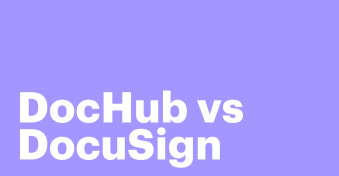Electronic signatures have become essential to how modern businesses operate.
The ability to sign documents electronically through a secure platform reduces overhead, guards against non-repudiation, and increases the velocity of business for all parties involved.
Today, DocuSign is a leading player in the e-signature space.
The platform offers a suite of tools designed to streamline document workflows and simplify the digital signing process.
But does it live up to the hype?
In this review, we’ll take a closer look at DocuSign’s core features, user experience, pricing plans, and limitations to see if it’s the best fit for your business and help you make an informed decision.
Key takeaways
- DocuSign provides a suite of e-signature and document preparation tools that are intuitive and easy to use.
- With a wide range of plans and packages, this platform can accommodate teams of any size.
- Although a gold standard in e-signature capture, DocuSign lacks some key features that are available on other, competitive platforms.
Core features & functionality
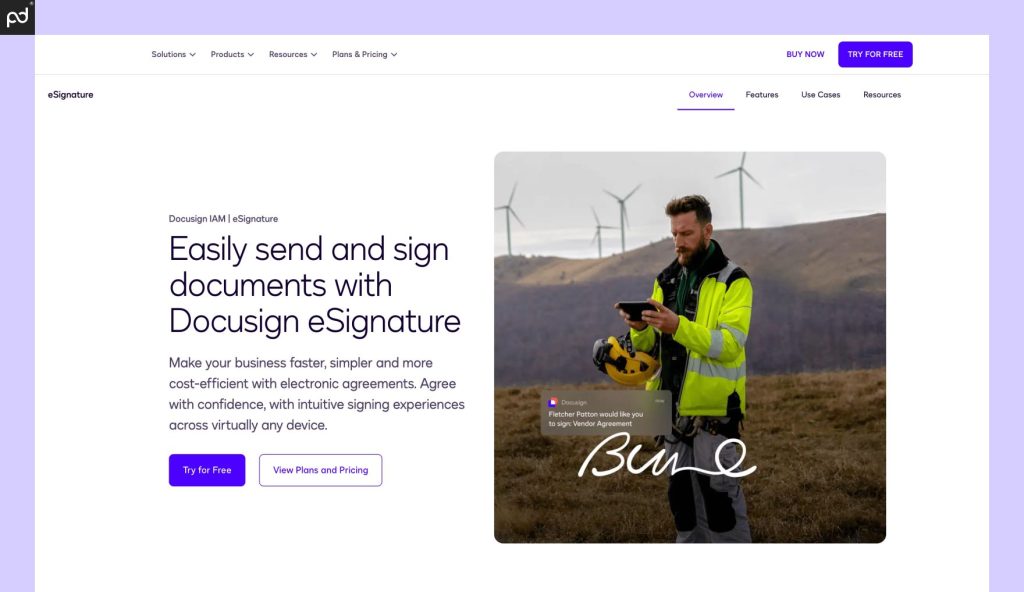
DocuSign’s core strength lies in its comprehensive suite of features designed to streamline document workflows.
This includes everything from its standard electronic signature capabilities to its form generation tools and robust integration options.
In this section, we’ll take a look at the core features that set DocuSign apart from the competition.
E-signing
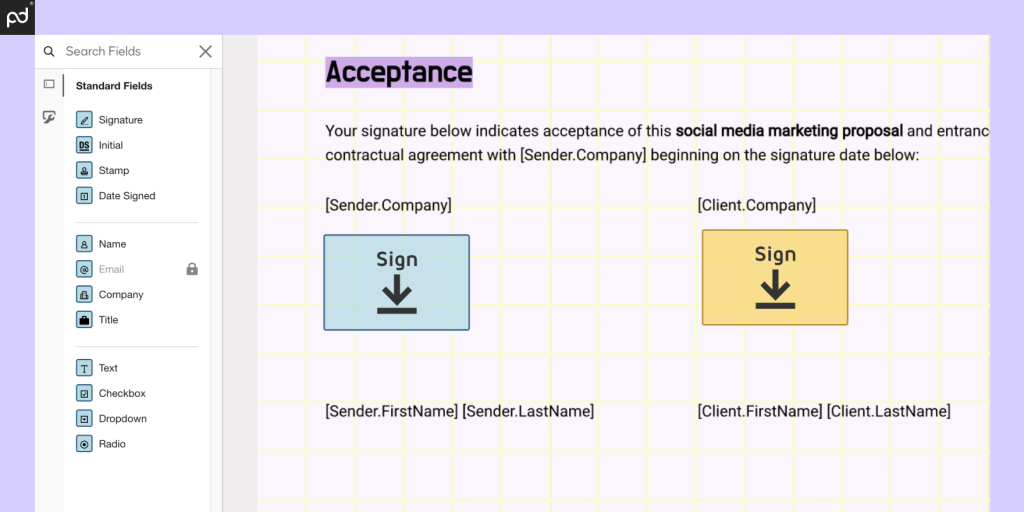
At its core, DocuSign excels in electronic signature capture for businesses of all sizes.
The platform offers a seamless process built to handle every aspect of the e-signing process. Senders will designate intended recipients, upload and prepare documents using drag-and-drop tools, and send documents to signers directly through the platform.
Like most digital signature services, DocuSign utilizes audit trails and notifications to keep all parties in the loop through every stage of the agreement process in real time.
Once documents are signed, they’re retained and stored on the platform indefinitely, along with the certificate of authenticity generated for each document.
Form generation

Although web form generation is restricted to Business Pro plans, it’s a key feature for e-signature platforms due to its versatility.
DocuSign is no exception.
The platform’s drag-and-drop functionality allows users to add text boxes, radio buttons, and other elements during document preparation.
These features allow recipients to answer questions and provide information on their own and are useful in scenarios where a business needs to gather information but may not have a specified recipient.
Examples include a generic questionnaire, a permission slip for a school function, or an inquiry form on a website.
DocuSign offers two basic types of forms: Web Forms and PowerForms.
Web Forms — which are widely available through multiple e-signing providers — offer an interactive experience for users and will generate a completed PDF.
PowerForms are unique to DocuSign and only present recipients with a PDF form to fill out.
Both solutions allow users to create self-service forms to capture data and signatures via a website or web application.
On the backend, users will create a template within DocuSign and then share a form created from that template via a sharable link or a website embed.
Once a user completes the form, all the information will be passed to the user via DocuSign.
Document management
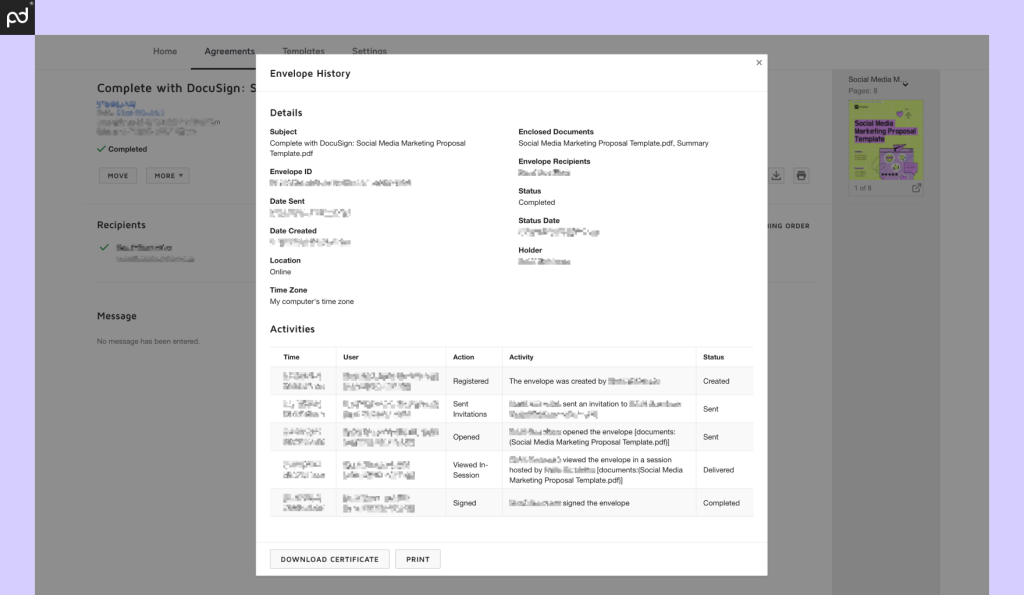
Beyond e-signatures, DocuSign offers a suite of document management features that enhance collaboration and organization.
Users can securely store and access documents in the cloud,
eliminating the need for physical filing cabinets and reducing the risk of lost or misplaced files.
The platform also allows for easy searching and filtering of documents based on various criteria, such as sender, recipient, date, or keywords, making it simple to locate specific agreements. (This is also possible on many other platforms, including PandaDoc!)
Users can share documents with colleagues and enable collaboration with external parties.
With multiple team members using the platform, it’s possible to set up approval workflows and review processes that must be completed before a document can be sent.
DocuSign also offers automated routing for complex documents, where documents can be automatically sent to designated individuals for review and signature in a pre-defined order.
This eliminates manual intervention and accelerates the overall document lifecycle.
Integrations
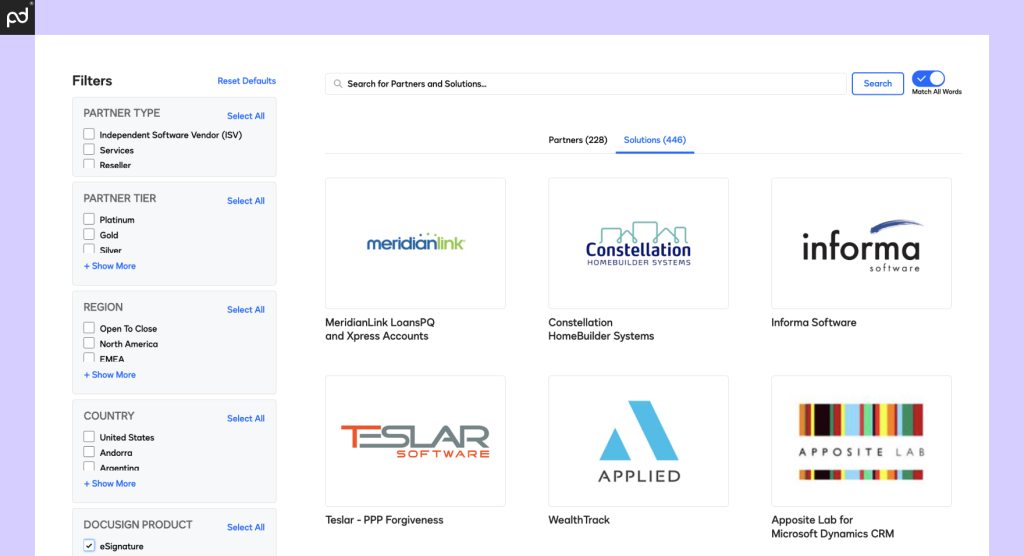
One of DocuSign’s key selling points is its wide selection of integrations.
While many DocuSign competitors offer integration options, DocuSign supports nearly 600 integrations from almost 400 partner brands, and the majority of these connectors are accessible for every plan level — including the Personal Plan.
This added extendibility allows users to connect DocuSign e-signatures to niche industry software, further streamlining sales and agreement processes in a user-friendly way.
If the integration exists, teams won’t need to create custom connections using API tools, offered by DocuSign and many other e-signing brands, or jump through extra hoops while signing documents.
Outside of integration with sales tools, DocuSign also offers integrations with popular productivity tools like Google Workspace and Microsoft Office.
Users can send documents for signature directly from Gmail or Outlook, and even have signed documents automatically saved to their Google Drive or OneDrive.
This eliminates manual steps and saves valuable time.
You’ll also see connectivity with popular CRM/ERP, including Salesforce, NetSuite, and Microsoft Dynamics.
However, those particular three tools are restricted to Enhanced Plans and are only available at the enterprise level.
Security
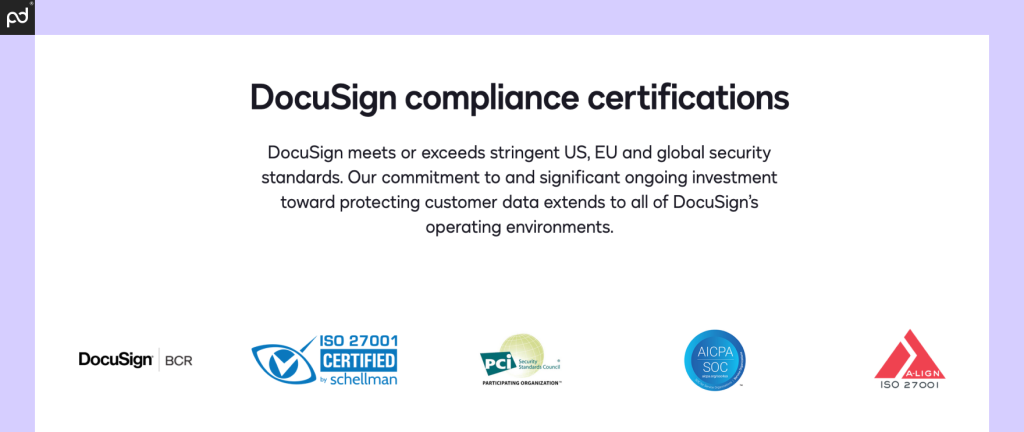
DocuSign places strong emphasis on its security technology and actively works to safeguard the sensitive information contained in its electronic transactions.
In many ways, the company is a leader in this space, employing multi-layered security and industry-standard algorithms to protect documents, signatures, and user data both in transit and at rest.
Like other industry leaders, DocuSign maintains strict compliance with various industry standards and regulations, including SOC 2 Type II, ISO 27001, and HIPAA (Enhanced Plans only).
The platform is also compliant with legal codes for the US and Europe, including eIDAS, GDPR, and more.
On higher-end plans, DocuSign offers advanced signer authentication processes.
These options allow senders to verify the identity of the recipient through a variety of means, including SMS, phone calls, or knowledge-based authentication questions.
Furthermore, DocuSign provides detailed audit logs (similar to what we do at PandaDoc) for every document, recording each step of the signing process — including timestamps and IP addresses.
User experience
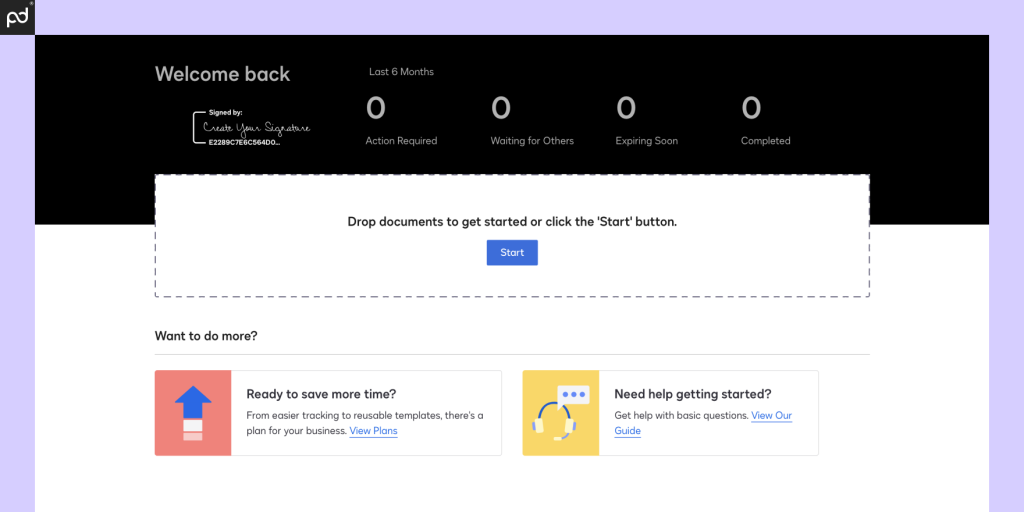
A seamless experience is essential for everyone involved in the e-signing process.
Senders need to be able to navigate the preparation process, assign recipients, and move documents through the pipeline.
Signers must be able to review documents and digitally sign the document.
This process becomes more complicated with complex documents or with documents that require multiple signers.
Here’s a closer look at the typical DocuSign user experience.
Interface
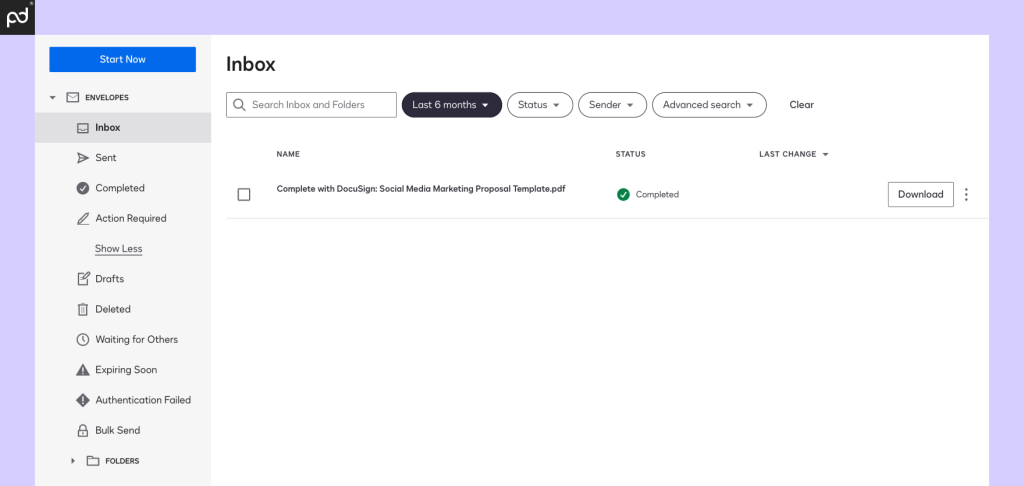
Overall, DocuSign’s user interface tries to strike a balance between functionality and ease of use.
The platform offers a clean and modern design that is well-organized and easily accessible for both novices and experienced users.
The user dashboard functions similarly to a modern mailbox, with documentation.
Outside of the drag-and-drop interface (covered in depth below), the DocuSign UI feels like working in a standard email inbox.
Users can track documents based on status, with the standard inbox covering all documents actioned over a given time period and various folders highlighting specific action items.
While DocuSign offers a mobile app, the UI is responsive in the browser and adapts well to a variety of screen sizes.
This ensures a consistent experience across various devices and makes it easy for users to monitor documents from anywhere.
Outside of the standard interface, DocuSign also offers extendibility through integrations with various software tools like Google Drive, Gmail, or Dropbox.
While the interface varies slightly depending on the partner application, connecting docs on various platforms with DocuSign’s e-signature tool and clean interface is relatively simple and straightforward.
Document preparation
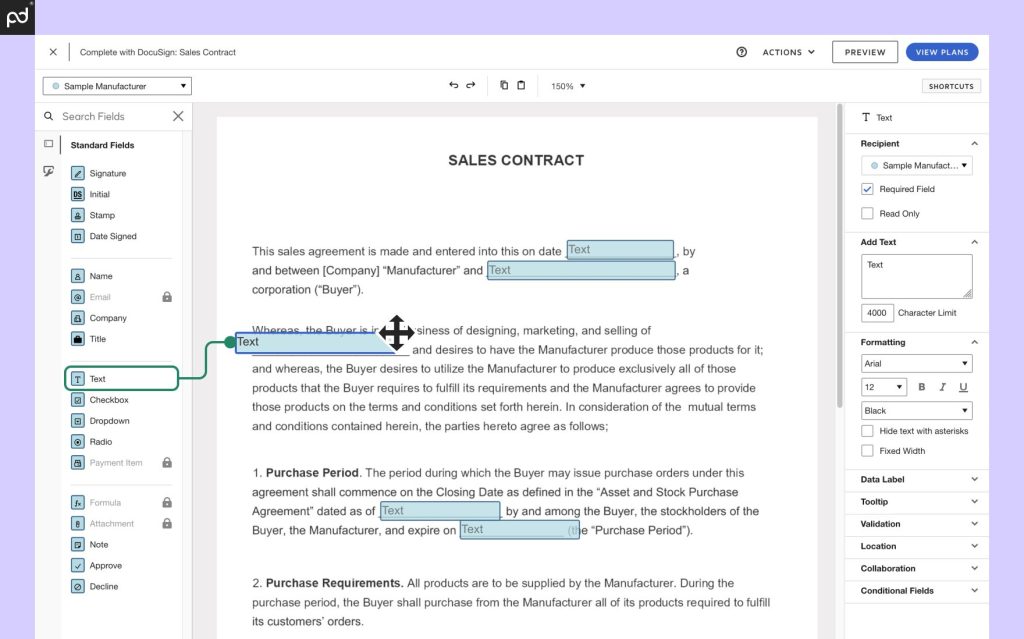
Like many other e-signature platforms, DocuSign streamlines document preparation with a drag-and-drop interface.
Users can add signature fields, initials, checkboxes, text fields, and other form elements to their documents inside the same preparation environment.
This functionality eliminates the need for complex formatting or coding and allows users with limited technical expertise to prepare documents for e-signing.
In many ways, the DocuSign approach to document preparation is the industry standard.
The platform lacks advanced features around formatting and preparation, like the functionality offered by PandaDoc and other live-editing tools or document builders.
DocuSign is instead designed to fit at the end of the document workflow, after documents have been written in a third-party word processing tool and are ready for e-signature capture.
When used within this scope, the platform provides a fair degree of customization.
Users can specify if fields are required or optional, set validation rules to ensure data accuracy, or even add conditional logic to create dynamic forms based on user input.
It’s also possible to resize and reposition fields as needed, further customizing the look and feel of DocuSign’s impact on the document.
Templating
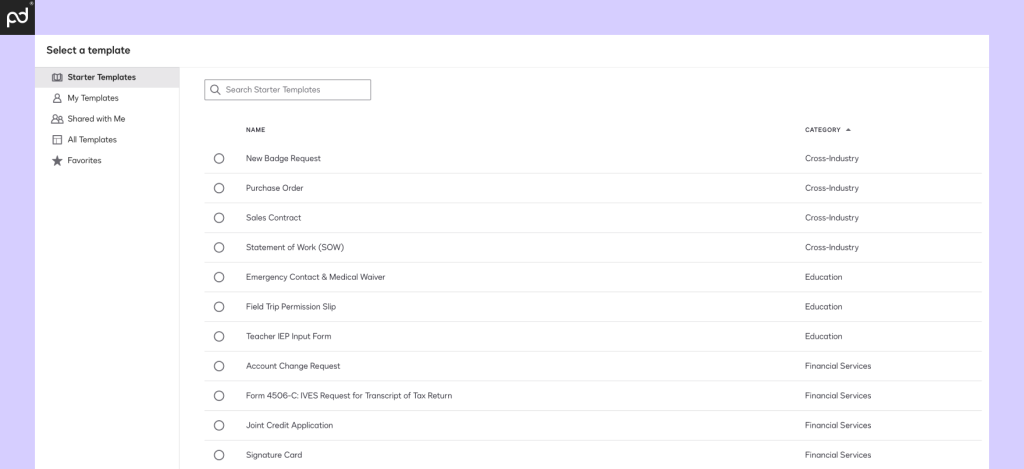
For those working with standardized documents or repetitive processes, DocuSign allows users to save prepared documents as templates.
These templates can be easily reused, saving time and effort when creating similar documents in the future.
The platform also provides a limited library of pre-built templates for common document types, further accelerating the preparation process.
Users can create dynamic templates with reusable fields, recipient roles, and workflows.
This means that when a template is used to create a new document, certain fields can be pre-populated with information from the sender’s address book or CRM system, further streamlining the process.
DocuSign also offers a pre-built template library with a few common document types, including basic NDAs, sales contracts, and tax forms.
While nowhere near as robust as the PandaDoc template library, this will give users just starting out a better understanding of how uploaded documents will interact with the DocuSign platform.
Dedicated users will find the ability to create and manage template libraries within DocuSign particularly valuable.
Created templates can even be modified, helping to ensure that organizations save time by keeping everyone on the most up-to-date and approved document formats.
Branding
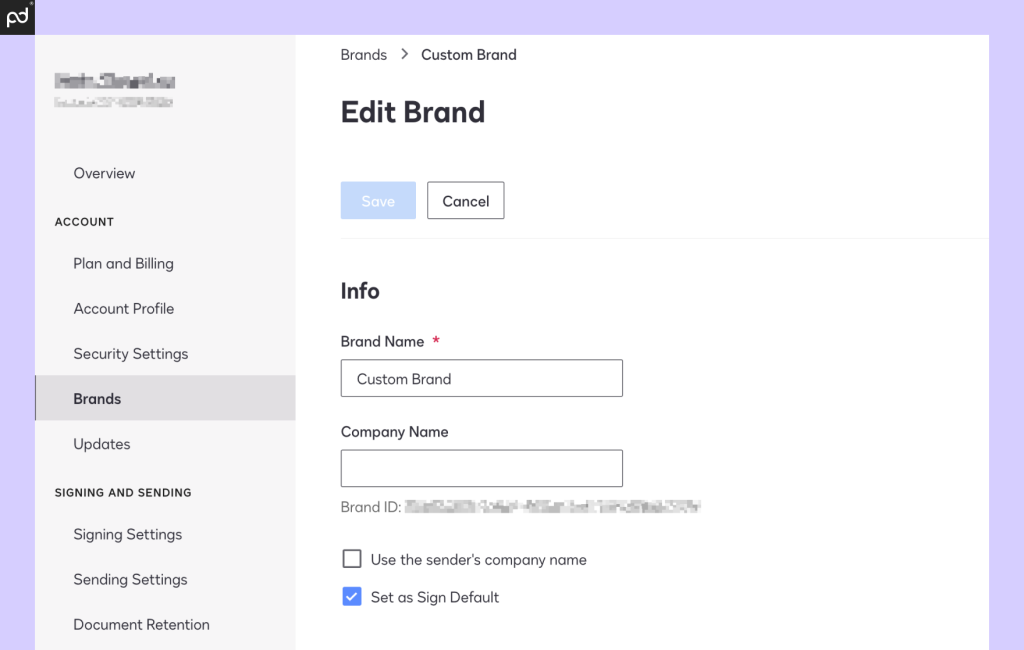
Maintaining brand consistency is critical for businesses, especially when dealing with important documents like contracts and agreements.
DocuSign offers a wide selection of branding customization options that allow users to tailor the look and feel of their documents and communications to their corporate identity.
Users can upload their company logo to be displayed prominently on documents, envelopes, and email notifications — similar to what you can do with PandaDoc.
This reinforces brand recognition and reassures recipients that the communication is legitimate. Additionally, DocuSign allows users to customize the color scheme of the signing interface and email notifications, ensuring a cohesive visual experience that matches their brand’s color palette.
Beyond logos and colors, DocuSign also provides customization options for email messages and PowerForm landing pages.
Users can modify this content to better reflect their brand voice and communication style.
For more advanced branding needs, DocuSign offers API integrations that allow for deeper customization.
However, it’s worth pointing out that DocuSign isn’t a white label solution.
Regardless of the customization options available, some form of DocuSign branding will persist on all communications dispatched through the platform.
Whether signing in-person or through an embedded web form (not docusign.com), signers will be able to see that DocuSign is your signing solution.
If you’re looking to avoid that entirely, OneSpan Sign is one of the only competitive solutions that offers a white labeling option.
Pricing & plans
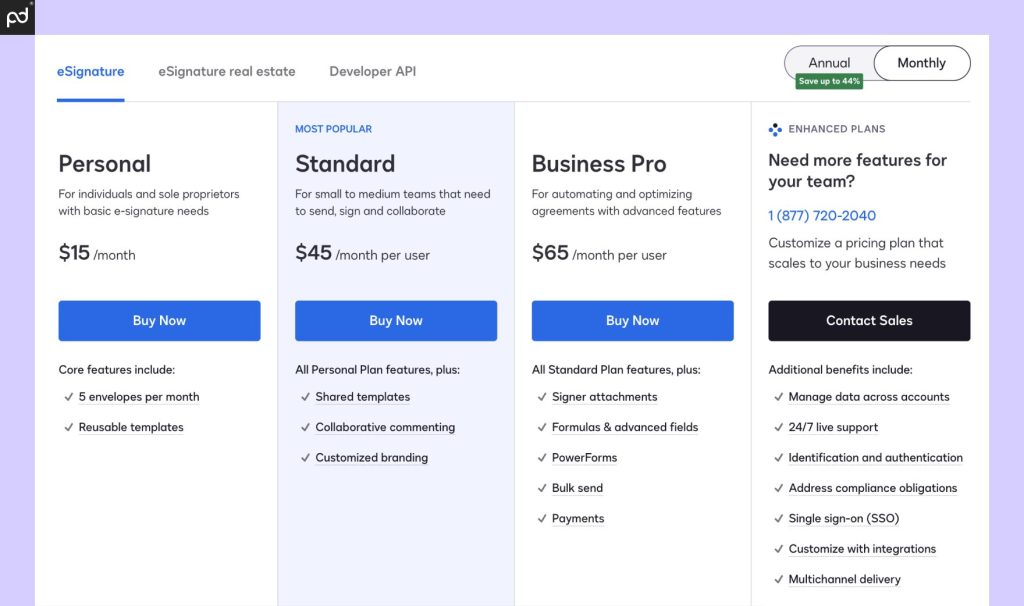
DocuSign offers a range of plans to fit the needs of most users, from individuals to large enterprises, but determining which plan is best suited to your needs can be tricky.
In this section, we’ll take a closer look at the costs and features associated with each plan to assess their value proposition.
You can also find a full breakdown of DocuSign pricing and relevant features right here.
Personal
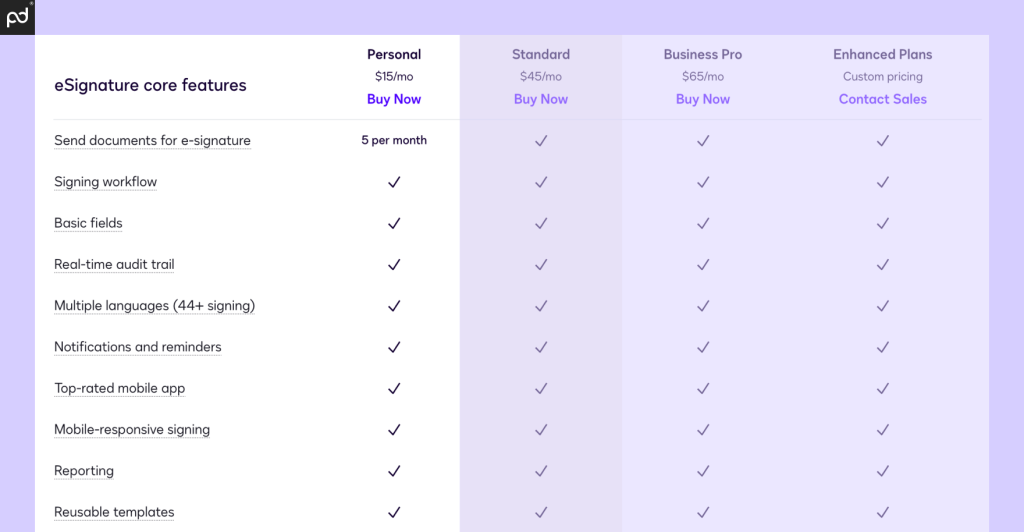
DocuSign’s Personal Plan caters primarily to individuals and sole proprietors with basic e-signature needs.
This plan provides access to most of DocuSign’s core signing features. Users can take advantage of reusable templates, connect to most partner integrations, and will have automatic access to standard document security, mobile apps, and more.
It’s a cost-effective entry point into the world of electronic signatures, providing essential features for personal use or small-scale business operations.
However, as the lowest-cost plan in the DocuSign lineup, this plan only provides basic functionality and lacks many of the advanced features found in higher-tier plans — including payment collection, available on all PandaDoc plans.
Subscribers on the Personal Plan are allotted five envelopes / transactions per month. In DocuSign terminology, this refers to a single document (or group of documents) sent for signature to one or more recipients.
While this restriction may be sufficient for individuals with sporadic signing needs, it may prove restrictive for businesses handling a higher volume of documents.
Standard

DocuSign’s Standard Plan, positioned one tier above the Personal Plan, is designed to cater to small- and medium-sized teams seeking to enhance e-signature capabilities and collaboration tools.
Like the Personal Plan, the Standard Plan provides access to most of DocuSign’s core e-signing features while also introducing a new toolkit.
Users on this plan can take advantage of collaborative commenting, customized branding, signer attachments, and productivity integrations for the first time.
However, like most other DocuSign plans at this level and above, the Standard Plan is limited to 10 envelopes per user/month and 100 total sends per user/year.
Team tools and multi-user options first become available on this plan.
Standard Plans can support up to 50 users and allow administrators to manage team member permissions in the workspace.
It’s also possible to generate reports, share templates, and delegate signing authority to other team members.
However, this plan lacks the functionality of the Business Pro and Enhance plans, in regards to customization, control, and versatility.
Business Pro
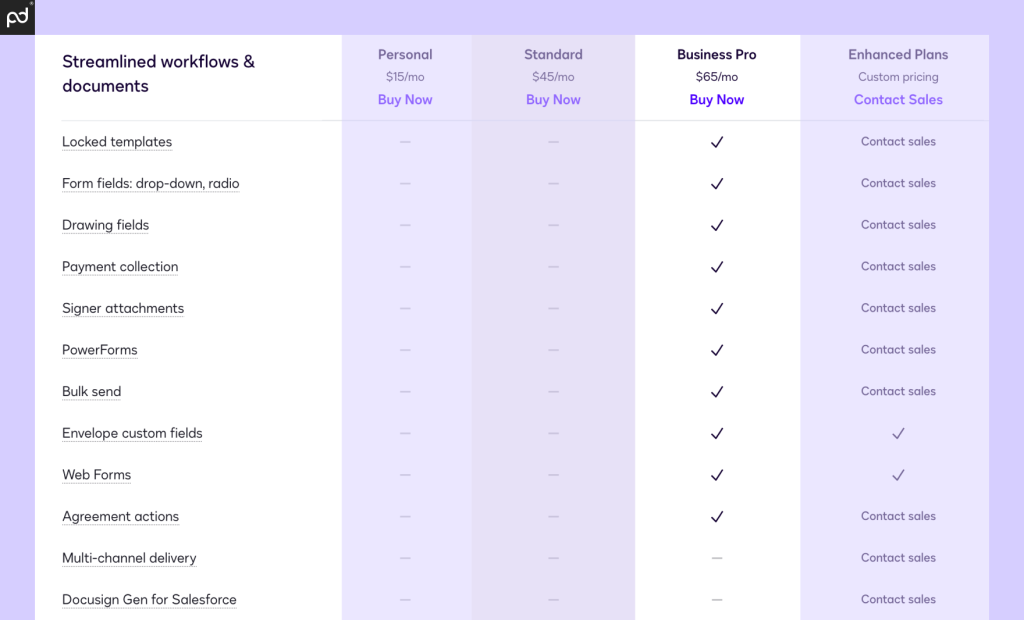
The DocuSign Business Pro Plan is one tier above the Standard Plan and is the highest tier available before custom plans.
This plan extends upon the capabilities seen in lower tiers and introduces additional features designed to streamline workflows and enhanced productivity.
In addition to the e-signing feature and collaborative functions found in previous plans, Business Pro offers advanced formatting options for documents, as well as the ability to collect one-time payments during the e-signing process. (Recurring payments are possible, but only with a separate subscription to DocuSign Payments.)
This plan also introduces form generation via PowerForms and Web Forms, enabling users to capture online data more easily.
Like the Standard Plan, the Business Pro plan is limited to 10 envelopes per user/month and 100 total sends per user/year.
In some ways, the plan restrictions feel more severe on Business Pro than on other plans due to the capabilities of the plan.
Between document preparation, form generation, and many of the advanced tools available, this plan benefits from a broad use case.
Users can personalize the user experience, request signer attachments, embed forms to websites for fast and easy data collection (every completed form consumes an envelope), or automate document sending with bulk send.
The problem is that many of these automations and turnkey solutions consume transactions, which quickly eats into that 100 envelope limit and, ultimately, drives up plan costs.
Enhanced Plan
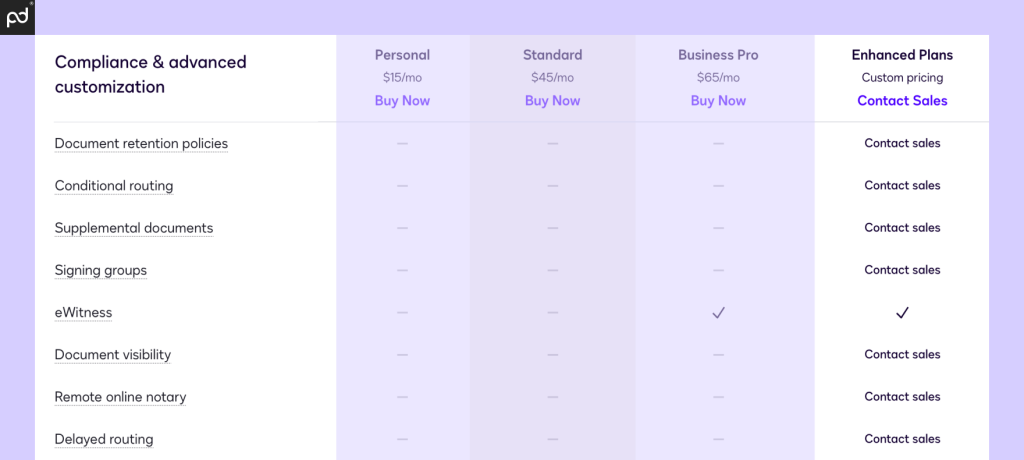
DocuSign’s Enhanced Plans cater to enterprise-level organizations with complex document workflows, advanced e-signature requirements, and convoluted tech stacks.
Unlike previous plans, which can be bought directly from the DocuSign website, Enhanced Plans are custom-built and can only be acquired by speaking with a sales team.
Because of this, each plan is tailored to fit the needs of the team who uses it. Comprehensive features may be involved, and the envelope limits that other plans are saddled with may be eased or lifted, further empowering users with no-limit automations and capabilities.
Of course, DocuSign reserves some of its best features for Enhanced Plan users. This includes integrations with NetSuite, Salesforce, and Microsoft Dynamics.
This also extends to security features like HIPAA compliance, data residency, and advanced user authentications.
At the same time, because many elements of the plan must be negotiated through sales, some of the features available by default in lower-tier plans may not be included on the Enhanced Plan.
For example, PowerForms and payment collection are included by default on Business Pro. However, these features will need to be negotiated into an Enhanced Plan and aren’t immediately guaranteed.
Without a doubt, these plans are the most capable that DocuSign offers, but they’re not as easy to acquire as plans from previous tiers.
Other plans
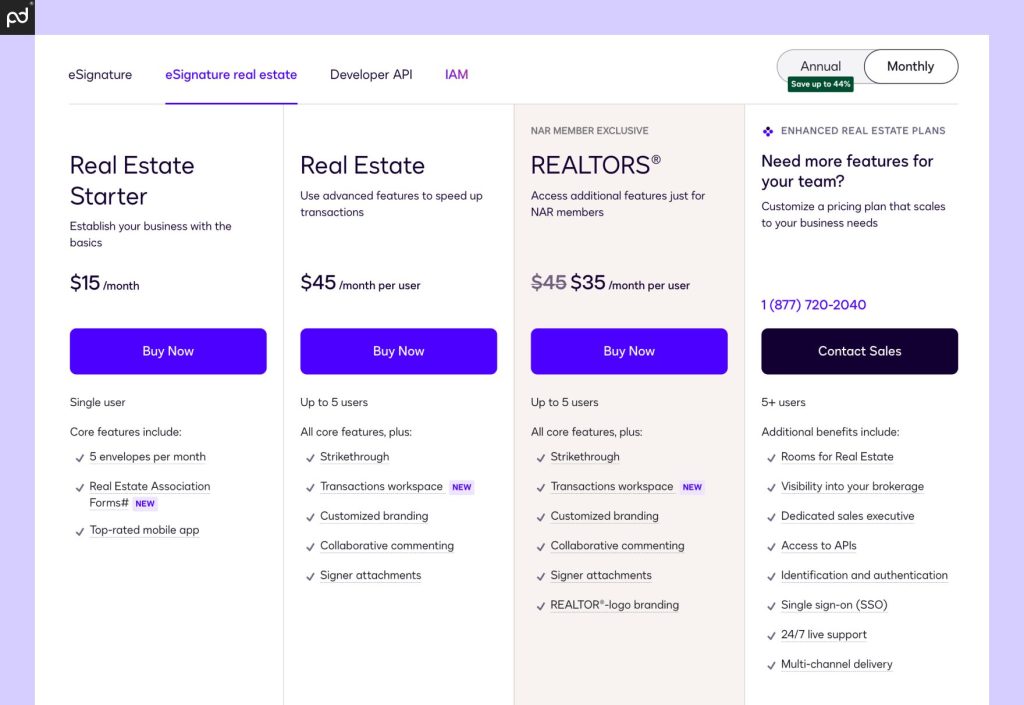
Outside of its standard plans, DocuSign offers a specialized collection of plans tailored specifically to realtors and real estate transactions.
These plans include a unique selection of features like a transaction workspace, strikethrough capabilities, and the ability to use standardized industry forms from the very beginning.
While we won’t cover these plans in depth here, DocuSign partners closely with the National Association of Realtors (NAR) when creating these plans.
By default, these plans are included as part of NAR benefits, so realtors with NAR will find these to be a natural fit.
It’s worth noting that other tools and platforms, such as dotloop, also exist for realtors who want a more seamless experience during the negotiation process.
Limitations & restrictions
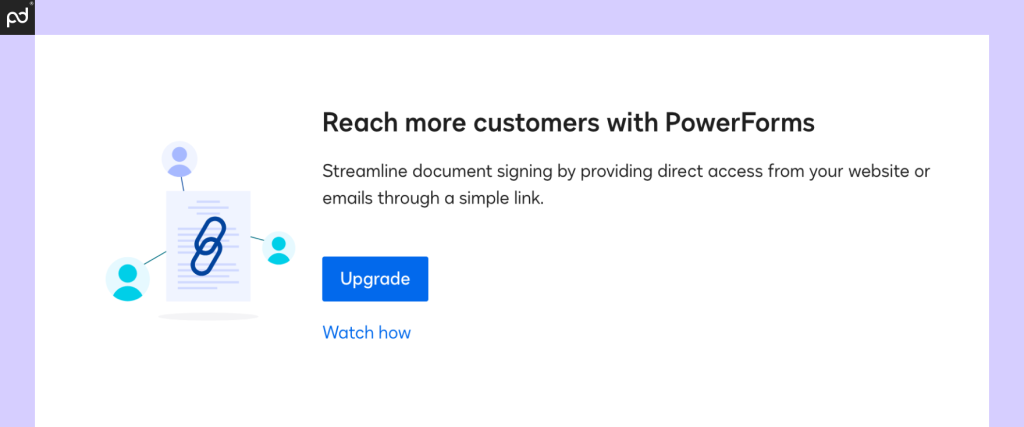
While DocuSign boasts a wide array of features, it also comes with a fair number of usage restrictions.
Some features aren’t available on all plans, and all plan have transaction limits that can increase costs and cause unexpected delays for unaware users.
This section covers DocuSign’s limitations and provides a realistic picture of what users should expect.
Use case & scope
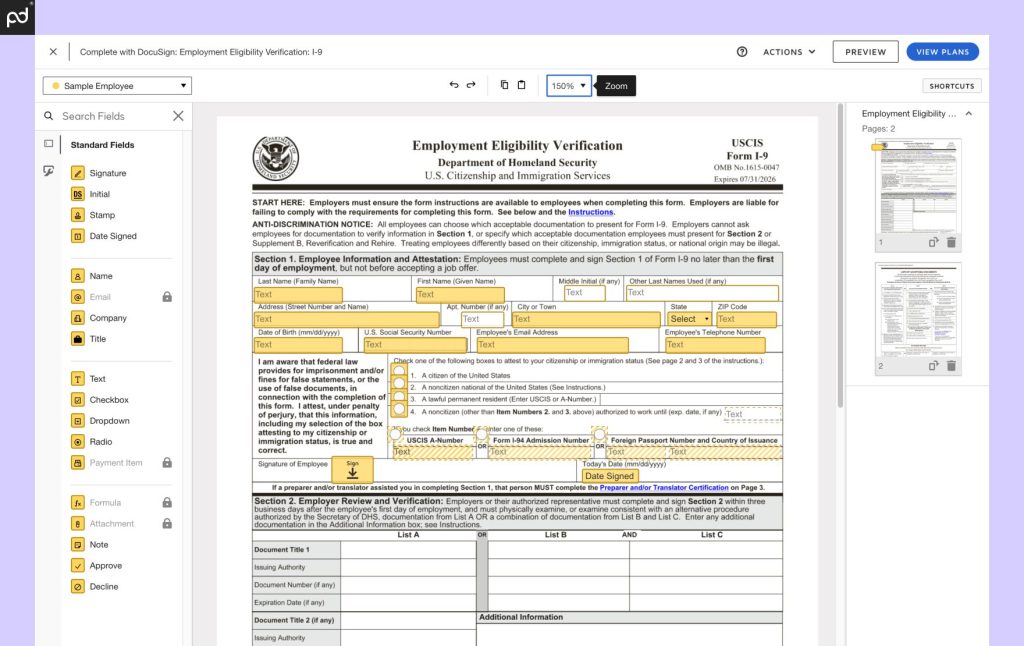
Perhaps one of the greatest drawbacks of using DocuSign is its scope of functionality compared to its competitors.
The platform performs at a very high level for its use case, but that use case is a relatively narrow slice of the document workflow.
DocuSign excels at electronic signatures and basic document management tasks, but it falls short when compared to competitors with more comprehensive solutions like onboard document editing or end-to-end CLM processes.
For example, DocuSign doesn’t allow for from-scratch document creation in any form like you’ll see in PandaDoc, Proposify, GetAccept, and many other cloud-based document platforms.
However, these tools include formidable e-signing workflows of their own and are priced competitively with DocuSign, meaning that users will get more for the investment on those platforms.
This is a strategic decision on DocuSign’s part, as the platform is the market leader in e-signature capabilities.
It’s possible to cover these shortfalls by investing in products like DocuSign CLM or DocGen. While these products will extend DocuSign’s capabilities around contract lifecycle management and document generation respectively, they come with much higher costs and are separate from DocuSign’s e-signing plans.
With that in mind, it’s crucial for both new and existing users to evaluate their specific needs and use case before committing to DocuSign.
While the platform excels in what it offers, several comprehensive and cost-effective solutions are available in today’s e-signing market.
Envelopes & transaction limits
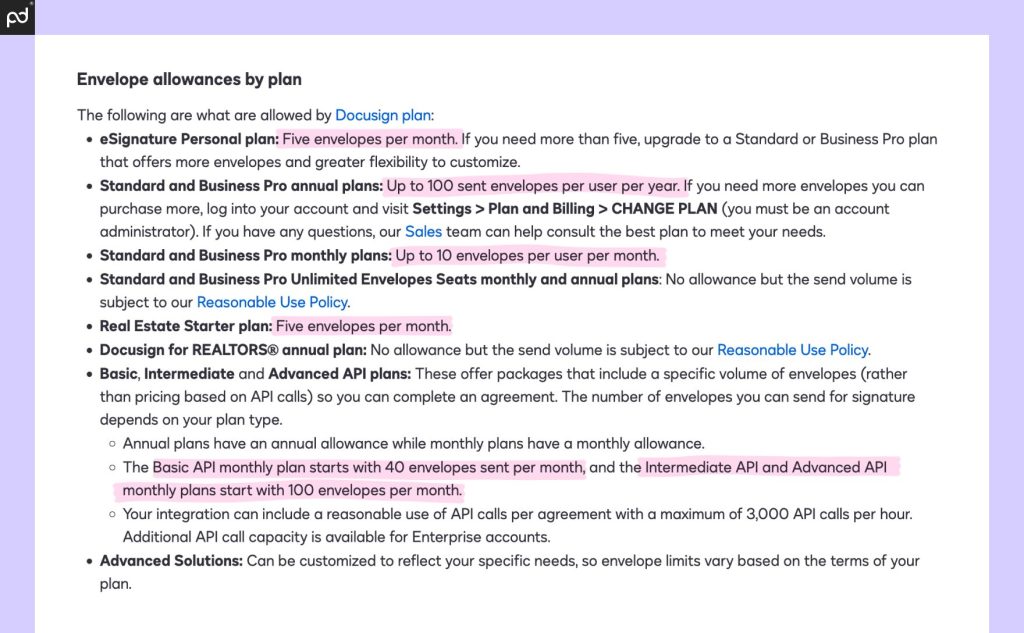
An envelope refers to the process by which a document is sent through the DocuSign platform. Envelopes can contain a single document or a set of documents (if prepared together), and can be sent to one or more recipients.
For example, an HR rep sending a hiring package to a prospective employee, their manager, and all individuals who need to approve the higher can prepare all of those documents simultaneously, bundle them together, and send them to the appropriate parties.
If all documents are sent together to the same collection of users, DocuSign would count that as one envelope.
On the other hand, if a sales rep needs to send a one-page invoice to a customer at the end of the month, sending that document to a single email address would also count as one envelope.
The majority of plans available through DocuSign carry an envelope limit of 100 transactions per year and 10 transactions per month.
This can severely limit plan functionality, especially for high-volume senders. While it’s possible to raise the send limit, doing so will incur additional fees and costs on top of existing plan prices.
Unfortunately, limitations on sent documents are an industry standard in part because of the limitations that DocuSign has placed on their product.
As the industry leader, many competitors have replicated DocuSign’s limitations in order to narrow the scope of their own product.
However, that isn’t always the case.
A few brands, including PandaDoc and Dropbox Sign, don’t have transaction limits. For teams who would prefer to enjoy no-limit sending, these solutions may be a better fit.
Support options
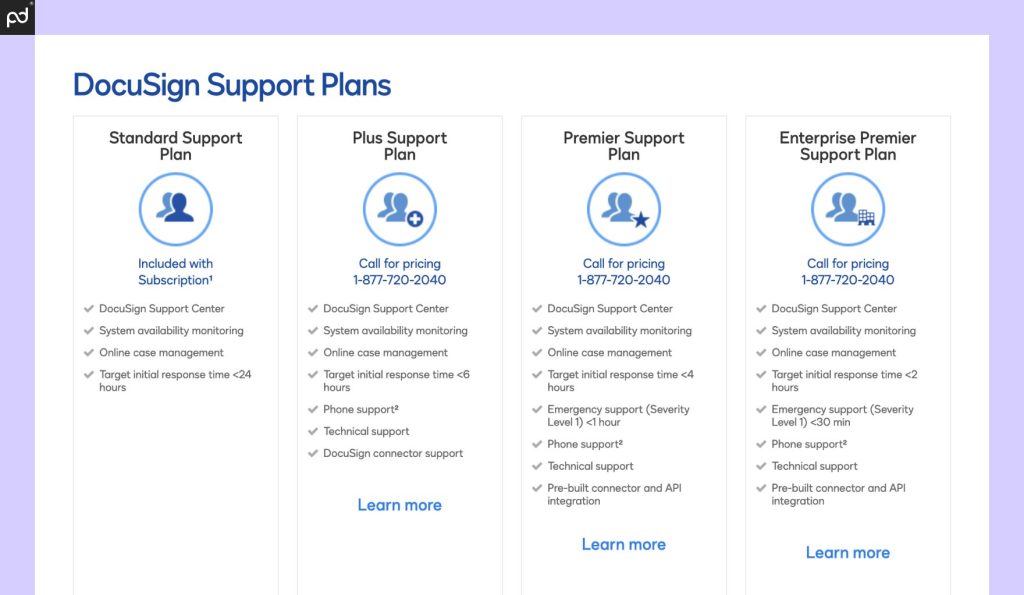
DocuSign offers a variety of support options for users with varying needs and preferences.
The primary resource for support is the DocuSign Support Center, the company’s online knowledge base.
However, the Standard Support Plan is also included with any DocuSign subscription.
Beyond those standard options, paid support subscriptions are also available.
These decrease the interval between support responses and provide additional layers of support.
Notably, DocuSign doesn’t offer live chat functionality, which is common among DocuSign competitors (and free for all PandaDoc users).
Customers with more complex and urgent needs are likely to appreciate the premium support options, dedicated account managers, and priority access that are available in higher-tier plans.
Typically, these solutions are targeted more toward enterprise-level customers with large-scale deployments essential document workflows.
While DocuSign does offer a comprehensive support solution, upgrading a support tier is separate from upgrading your standard DocuSign plan.
It’s an important detail, as all support packages above the default will incur additional costs.
Alternatives
Although DocuSign holds a prominent position in the e-signing industry, it’s not the only solution on the market today.
Several competitors offer a similar feature set, and many modern solutions combine e-signing with other unique aspects of the document workflow or sales process.
Briefly, here’s a look at a few DocuSign alternatives you might want to consider. (Check out a complete list right here.)
Other e-signing solutions
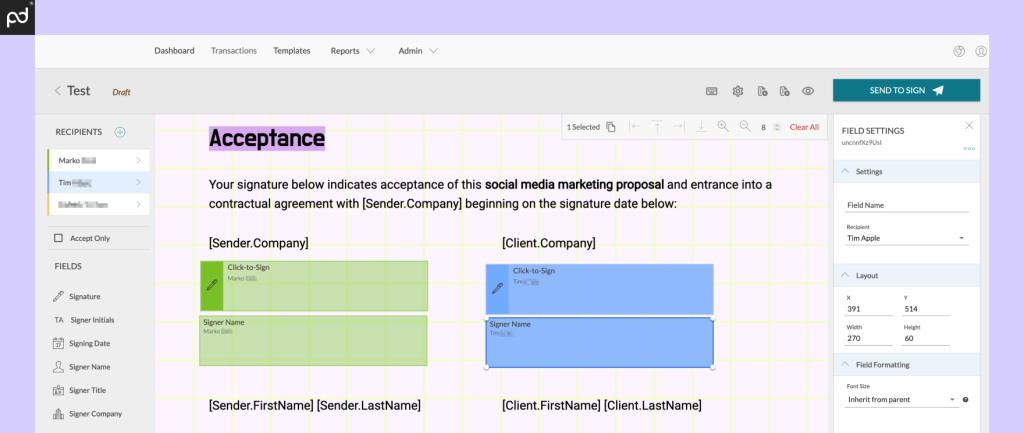
As an e-signing solution, DocuSign offers strict guardrails around its product features.
The platform is designed to fit at the end of the document workflow, meaning that users will need to design documents elsewhere before uploading them to DocuSign to prepare them for e-signing.
Below, you’ll find a list of tools that offer functionality similar to DocuSign and are direct competitors to the brand.
- SignNow. A budget-friendly e-signing solution known for its simplicity and mobile-first approach.
- Dropbox Sign. A digital signature solution that integrates seamlessly with Dropbox storage.
- OneSpan Sign. A security-focused e-signing solution tailored for enterprise and regulated industries.
- SignEasy. An AI-powered, mobile-friendly electronic signature and contract summary tool.
- SignRequest. A powerful signing solution that prioritizes ease of use and affordability.
These tools will make the most sense for users who already have a process in place to handle other aspects of the document workflow and only need a signing solution.
Below, we’ll cover solutions that go far beyond e-signing and offer a more comprehensive document process.
Beyond e-signing
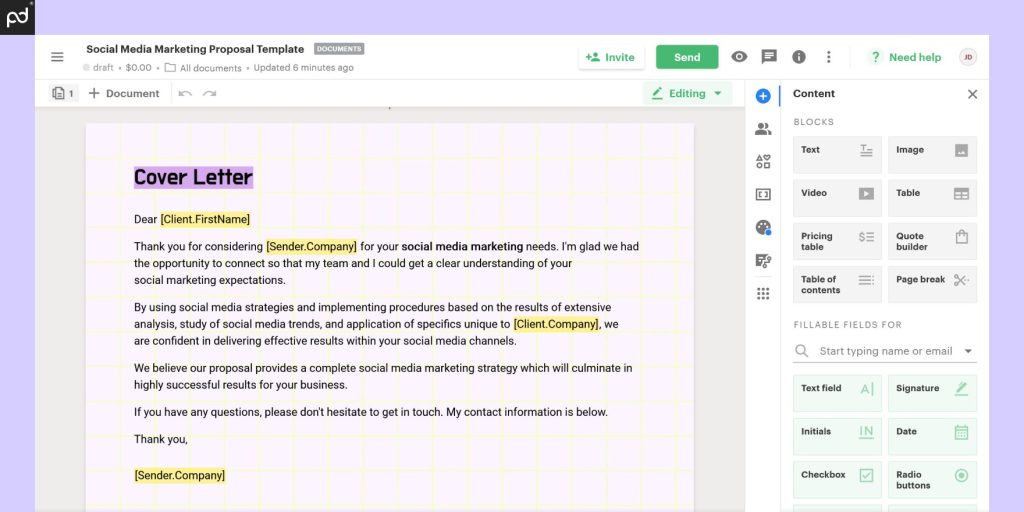
While DocuSign offers a narrowly scoped digital signature process, many brands now offer e-signature capture as part of an extended document process.
Tools that go beyond e-signing include proposal generation software, contracting software, and advanced PDF editors.
These platforms are built to replace a larger portion of your document workflow and typically compete with dedicated e-signing tools, word processing tools, and sales pipeline tools at the same time.
- PandaDoc. A robust document automation platform that combines e-signatures with proposal and contract creation tools.
- Adobe Sign. A comprehensive e-signature solution integrated with Adobe Acrobat, offering powerful PDF editing and collaboration tools.
- Proposify. A proposal generation software offering ultra-precise drag-and-drop editing and e-signing capabilities.
- GetAccept. A sales-focused e-signature platform with built-in tools for proposal creation, document tracking, and payment capture.
- Sharefile Premium. A secure file-sharing and document management platform featuring integrated e-signature functionality.
While the platforms listed above do a great job capturing full document workflows, they may not be a great fit for organizations with an inflexible document process.
The power in these tools comes from consolidation — the ability to handle everything on one platform without switching across multiple tools in the tech stack.
Teams in need of a more niche or single-function solution may not see as much use with these tools.
Better documents & signatures with PandaDoc.
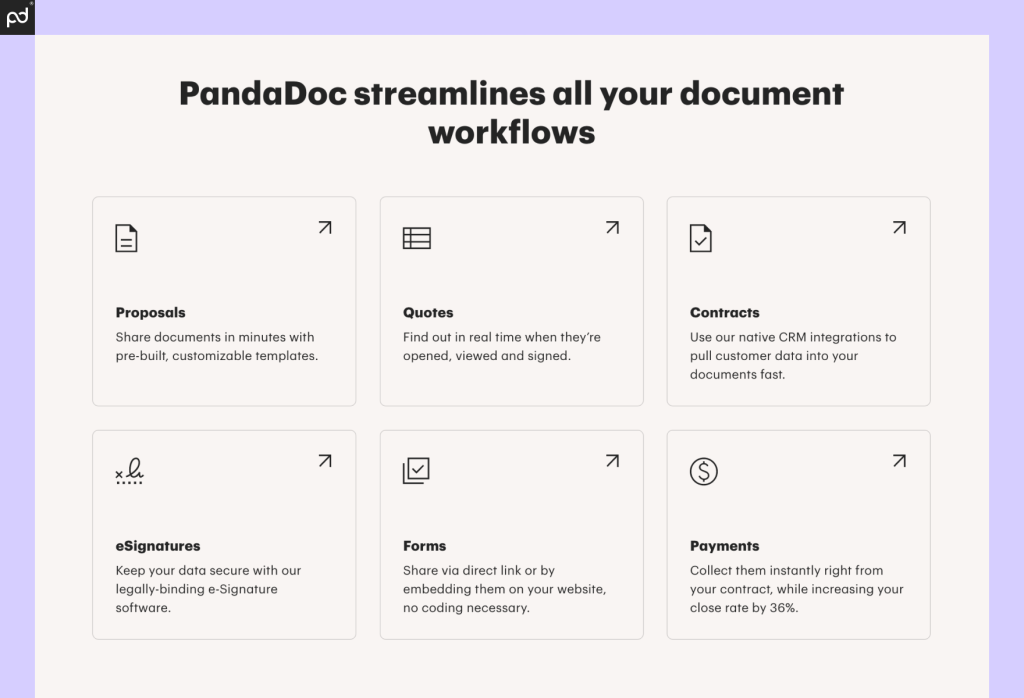
While DocuSign is a strong contender in the e-signature market, PandaDoc is a formidable alternative for businesses who need a more comprehensive document solution.
Beyond basic e-signatures like those DocuSign provides, PandaDoc offers robust proposal and contract creation tools, streamlined content management, and in-depth analytics to track document engagement.
Put another way, PandaDoc is focused on the entire document lifecycle — not just the digital signature at the end.
Take a test drive with PandaDoc for free with a 14-day trial or request a demo for a personalized walkthrough of the product and how it can be tailored to suit your business needs.
Disclaimer
Parties other than PandaDoc may provide products, services, recommendations, or views on PandaDoc’s site (“Third Party Materials”). PandaDoc is not responsible for examining or evaluating such Third Party Materials and does not provide any warranties relating to the Third Party Materials. Links to such Third Party Materials are for your convenience and do not constitute an endorsement of such Third Party Materials.
Originally published June 2, 2023, updated August 19, 2024

